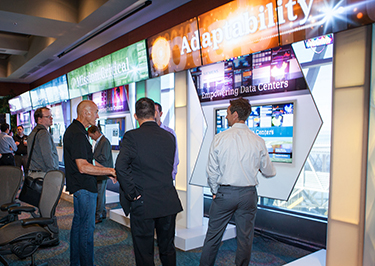|
Subscribe / Renew |
|
|
Contact Us |
|
| ► Subscribe to our Free Weekly Newsletter | |
| home | Welcome, sign in or click here to subscribe. | login |
Environment
| |
 |
September 26, 2013
Is your data center as green as it can be?
Siemens

Kovach
|
Seattle is a vital communications and technology hub for the Pacific Northwest. It is home to such companies as Amazon and Microsoft, as well as many other network and cloud service providers and digital media companies. The concentration of these highly connected companies is why Siemens selected Seattle to host one of three in-depth conversations on “The State of the Data Center” — to capture the constraints faced by the industry and develop solutions that help transform and prepare data center providers for future market needs.
A business’s data is one of its most valuable assets, and it must be protected while keeping in mind the organization’s energy usage and bottom line. It’s no secret that data centers are one of the largest users of energy, consuming more than 2 percent of all electricity generated in the U.S. In addition, global data center power requirements have grown by an estimated 63 percent growth in recent years — prompting companies to look for more efficient power and cooling strategies.
To safeguard data, organizations must ensure that their data centers are well-positioned to grow and evolve as business needs require. However, data center administrators are facing an array of challenges, from the exploding volume of data that organizations generate and consume to space constraints, power and cooling concerns, as well as the need to protect against physical threats. Even the availability of adequate power is becoming a challenge in some locations.
With budgets being an issue, companies are focusing on major fixes and upgrades, rather than investing capital in new buildings. More than half of IT executives we recently surveyed said they were actively considering or moving forward with installing more energy-efficient equipment.
Many IT executives say that their organizations have taken steps toward making their data centers greener, and they are clearly interested in reducing energy costs, but nearly half of them have no idea what percentage of their data center’s total cost of ownership is comprised of energy costs. A significant number also do not know their power usage effectiveness rating (how efficiently their data center uses its power). IT professionals are aware of how to make data centers greener, but they don’t monitor cost of energy as closely or consistently as they should.
Despite the unfamiliarity that many IT decision makers have regarding actual power usage numbers in their data centers, there is a widespread awareness of the importance of managing energy usage and trying to reduce it wherever possible. For example, as they make their data centers more environmentally friendly, IT executives anticipate the largest benefits will be lower energy costs and better compliance with regulations.
Many companies are planning further steps toward making their data centers greener, and a large number say they would like to go in this direction. So the desire to go green is there, it’s partly a matter of being aware of available options.
Still, employing energy-saving technologies can require an initial investment that many IT budgets simply can’t accommodate. So, rather than invest in costly projects such as installing solar panels, companies are going after smaller adjustments, such as hot aisle-cold aisle assignments.
The most common techniques used are enhancing air handling to be as efficient as possible, using power management tools, hot aisle-cold aisle containment and detailed power monitoring. Some data center providers, in an effort to keep costs low for their customers, are embracing more sophisticated technologies such as ambient cooling using outside air and fuel cells to create electricity.
Limiting power consumption by idling resources is another option, as not all servers need to be operational 24 hours a day. Servers used for backing up or testing software can easily be powered down when not in use. About a quarter of companies we spoke with said they plan to buy hardware that dynamically adjusts power usage to the level of performance required by a given workload.
Any plan to optimize a data center would be incomplete without addressing management tools. IT administrators need detailed visibility and control over all aspects of data center operations so they can monitor the infrastructure and identify potential problems before they escalate.
Data center infrastructure management (DCIM) solutions enable IT administrators to remotely monitor and manage hardware, electrical power delivery, equipment and facility cooling, fire and life safety systems, and building security. DCIM provides a holistic view of a data center’s resources, allowing IT to create a “virtual data center” that predicts and visualizes the outcome of power and cooling decisions.
This capability provides a “what-if” analysis before installing, moving or changing any equipment, enabling better analysis of how a different layout or scenario will affect business operations. Just as importantly, DCIM enables data centers to perform more efficiently and support the delivery of business services. It’s a strategic investment that helps not only the IT department, but also the entire organization by improving business agility.
With the amount of data growing day by day along with electricity costs, it’s clear that the need to improve energy efficiency will be a dominant driver in the market in the coming years. As data center needs and requirements continue to evolve, data center managers have to be aware of the tools and solutions available to stay on top of these changes.
John Kovach is Siemens’ global head of data centers.
Other Stories:
- Wastewater plant cleaned up for the 21st century
- What’s next in green building? Seattle has it
- Surveys 2013: Plauche & Carr LLP
- Surveys 2013: Optimum Energy
- Surveys 2013: GeoEngineers
- Surveys 2013: Cascadia Consulting Group
- Surveys 2013: Hart Crowser
- Surveys 2013: Innovex Environmental Management
- Surveys 2013: Shannon & Wilson
- Lower your energy bill by 75% with a Passive House
- Dairies struggle to balance business and the environment
- Murky floodplain rules sink development plans
- Protecting Puget Sound’s marine shorelines
- At the UW, smart grids put a lid on energy use
- Rising sea level threatens Port Gamble tribe
- Surveys 2013: Ridolfi Inc.



